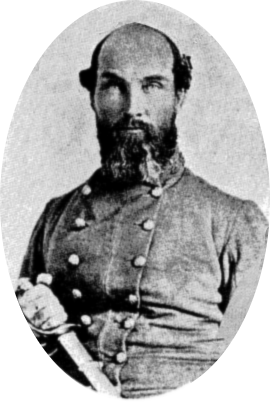John R. Baylor facts for kids
Quick facts for kids
John R. Baylor
|
|
|---|---|

Baylor in uniform, c. 1861
|
|
| Member of the C.S. House of Representatives from Texas's 5th congressional district |
|
| In office May 2, 1864 – May 26, 1865 |
|
| Preceded by | M. D. Graham |
| Succeeded by | Constituency abolished |
| 1st Governor of Arizona Territory (Confederate) | |
| In office August 1, 1861 – March 17, 1862 |
|
| Preceded by | Dr. L. S. Owings (provisional) |
| Succeeded by | Dr. L. S. Owings (in exile) |
| Personal details | |
| Born |
John Robert Baylor
July 27, 1822 Paris, Kentucky, U.S. |
| Died | February 6, 1894 (aged 71) Uvalde County, Texas, U.S. |
| Resting place | Church of the Ascension, Uvalde County, Texas, U.S. 29°32′21.5″N 100°00′44.4″W / 29.539306°N 100.012333°W |
| Political party | Democratic |
| Relatives |
|
| Military service | |
| Allegiance | |
| Branch/service | |
| Years of service | 1861–1865 |
| Rank | |
| Commands | 2d Texas Cavalry Regiment |
| Battles/wars | American Civil War |
John R. Baylor (born John Robert Baylor; July 27, 1822 – February 6, 1894) was an important figure in Texas history. He worked as a US Indian agent, a newspaper publisher, an editor, and a politician. He also served as a high-ranking officer in the Confederate States Army during the American Civil War.
After losing his job as an Indian agent, Baylor helped start a newspaper called The White Man in North Texas. He often spoke out against Governor Sam Houston.
During the Civil War, Baylor led Texas Confederate soldiers into New Mexico. He declared himself the first Governor of the Arizona Territory. This position was later confirmed by Confederate President Jefferson Davis. Baylor was later removed from his role as governor because of a controversial order he gave about Native Americans. He also had a serious disagreement with a newspaper editor that led to a fatal outcome.
Later in his life, Baylor settled in San Antonio. He was elected to the state government and became a rancher. He passed away at his ranch in 1894.
Contents
Early Life and Family
John R. Baylor was born in Paris, Kentucky in 1822. His father was a surgeon in the United States Army. John had a brother named George Wythe Baylor, who also joined the military and became a colonel. The boys grew up moving to different army posts where their father was stationed.
Their uncle, R.E.B. Baylor, became a judge on the Texas Supreme Court. He also helped start Baylor University. Another relative, Colonel George Baylor, was a hero in the American Revolution.
Life in Texas
John Baylor moved to Fayette County, Texas when he was 18 years old. In 1840, he joined a group of Texas volunteers to fight against the Comanche people. In 1844, he married Emily Hanna in Marshall, Texas. They had seven sons and three daughters. His brother George also moved to Texas.
While working as a rancher, Baylor decided to get involved in politics. He was elected to the Texas state legislature in 1851 and served until 1854. In 1855, he was appointed as an agent to the Comanches. He held this job until 1857.
After losing his job, Baylor traveled around Texas. He spoke out against the Comanches and attended meetings that were against Native Americans. During this time, he edited an anti-Native American newspaper called The White Man. He also organized a group of about 1,000 men to campaign against the Comanches.
Baylor was a strong critic of Governor Sam Houston. He believed Houston was not doing enough to protect settlers in North Texas from the Comanche and Lipan Apache. By 1860, he became a co-founder and editor of The White Man newspaper. This paper supported removing Native Americans from North Texas. It was based in Jacksboro, a town on the Butterfield Overland Mail Route, and reached many readers.
American Civil War
After Texas left the Union, Baylor became a Confederate lieutenant colonel. He was put in charge of the 2nd Texas Cavalry Regiment. His troops moved southwest into New Mexico Territory and took control of Fort Bliss.
Governor of Arizona Territory (1861–1862)
After winning the First Battle of Mesilla in July 1861, Baylor declared himself the Governor of Arizona Territory. This area included the southern parts of what are now New Mexico and Arizona. The Confederate Congress confirmed his position, and he was promoted to colonel in 1861. In January 1862, the Confederate States formally organized this new territory.
During his time as governor, Baylor had a serious disagreement with Robert P. Kelly, the editor of the Mesilla Times newspaper. This disagreement led to a fatal outcome.
Baylor became known for giving a very harsh order about how to deal with the Apache people. He ordered his soldiers to take extreme measures against them. When Confederate President Jefferson Davis learned about this order, he strongly disagreed. Because of these orders, Davis removed Baylor from his role as governor and took away his military rank.
C.S. House of Representatives (1863–1865)
Baylor later recovered his standing and was elected to the 2nd Confederate States Congress. He represented Texas from 1863 to 1865. He also regained his rank as colonel. He was in the process of forming a new force to try and recapture the Arizona Territory when the American Civil War ended.
Later Life
After the war, Baylor settled in San Antonio, Texas. In 1878, he started a large ranch in Uvalde County and became successful.
He died at his ranch on February 6, 1894, at the age of 71. He was buried in the Church of the Ascension cemetery.
Images for kids


